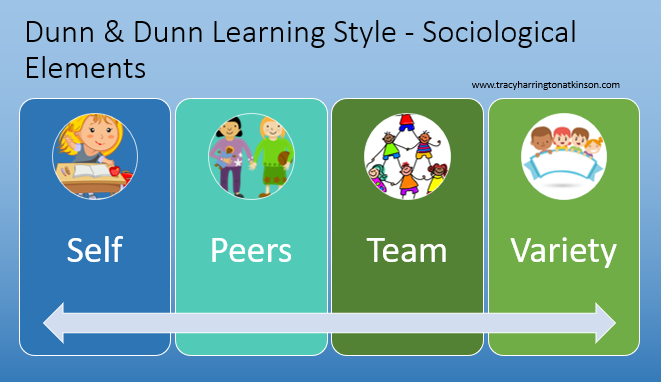
Sociological influences impact the social preferences of the learning environment. Is the student an independent or social learner? Do they prefer to learn in pairs with peers or even in small groups? Students may even enjoy working in a variety of these options.
Dunn & Dunn identify the following within the social preferences:
- Self
- Pairs
- Peers
- Team
- Adult
- Variety
Notice that not only does sociological elements address if students prefer to learn alone or with others, but it also addresses who they prefer to learn from. Some individuals simply want an authority figure. They will gravitate toward an instructor or teacher to aid them while others will experience anxiety and extreme pressure to be in an authority dominated situation.

Personalized Learning Inventory – Unlock Your Learning Potential: Discover Your Unique Style with the Dunn & Dunn Personalized Learning Assessment is a comprehensive guide that helps readers identify their individual learning preferences using the Dunn & Dunn model. This book provides an insightful assessment that allows learners to better understand their unique learning styles, focusing on key areas such as environmental, emotional, sociological, physiological, and psychological factors.
A great option for students who suffer from this type of anxiety is the on-the-job training model:
See One
Do One
Teach One

This puts students who struggle with authority in learning with options to learn from their peers.
If a student who needs an authority figure to learn from is put in a situation with peers, the educator may notice the sign of too much socializing going on. Simply move the socializing students to an authority teaching situation to determine the best mode of sociological elements for learning. Another sign is students who are belligerent or demand that they ‘pay’ good money to be taught by an authority rather than their peers. Again, this is a sign of a student who needs to be taught by an authority figure.
Of course, the difficulty for educators is to discover the best sociological makeup for the student. A single approach will not work for all students, requiring the teacher to mix up their methodologies. Also, try to be flexible. If you are going to assign students a group project, consider making a few pair projects where the groups are only two individuals. Students can be put together in ways to complete the assignment while still meeting their sociological needs.
Sources:
Dunn, R. & Dunn, K. (1978). Teaching Students Through Their Individual Learning Styles: A Practical Approach. Allyn and Bacon.
Subscribe to our YouTube Channel by clicking here.

Comments are closed